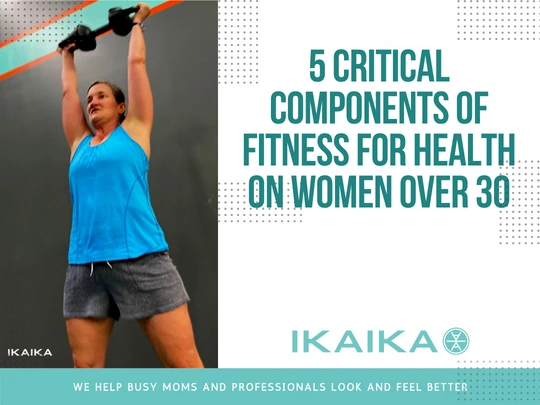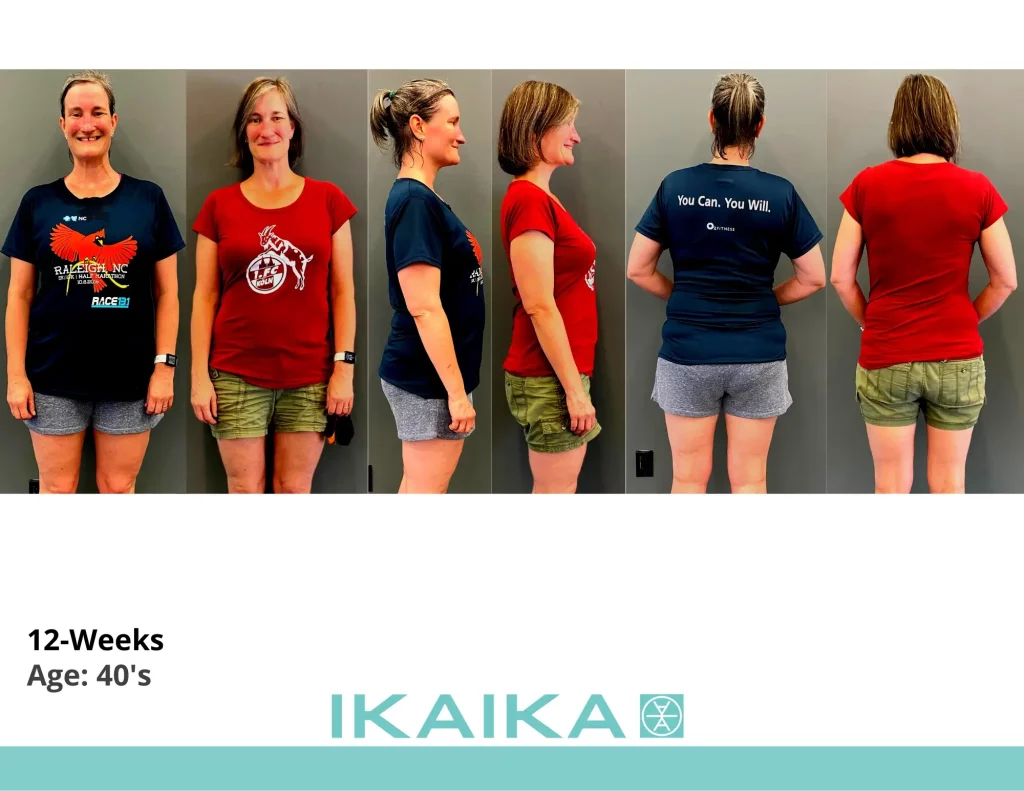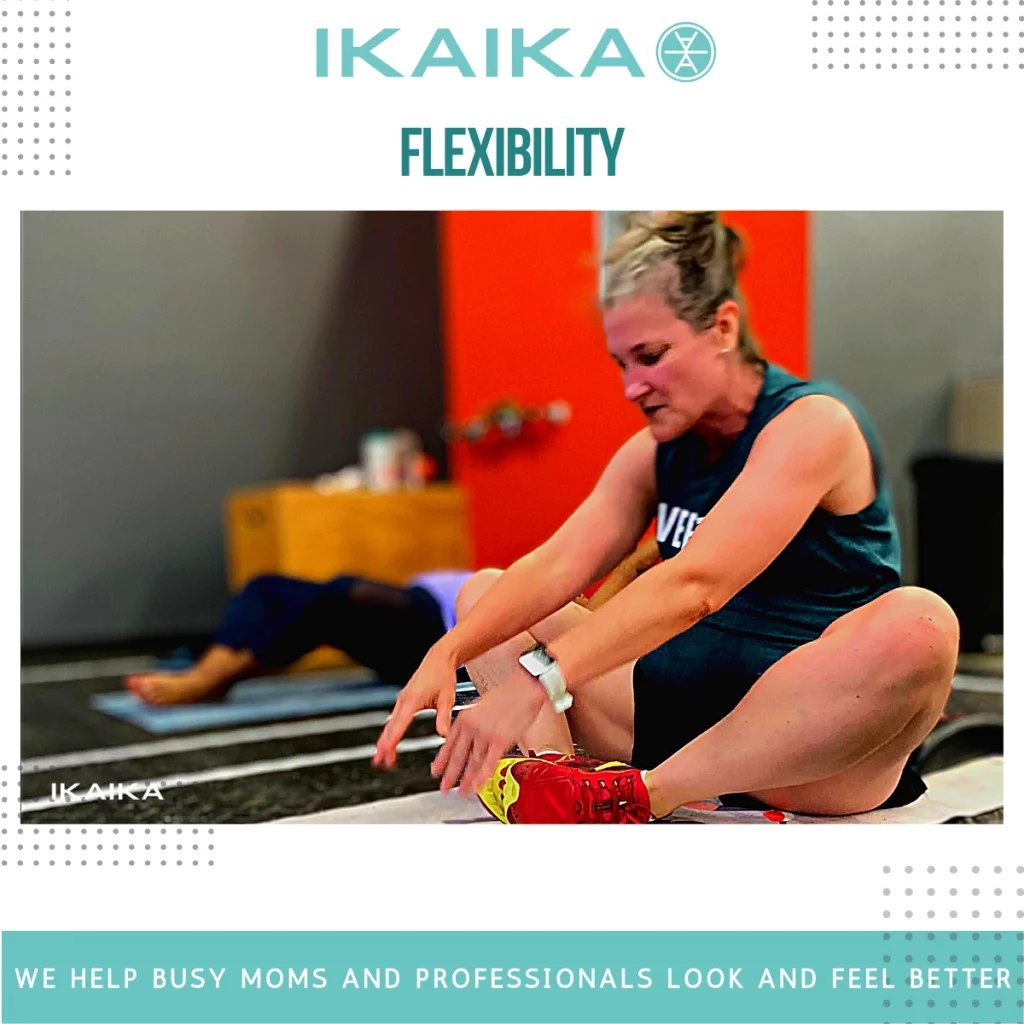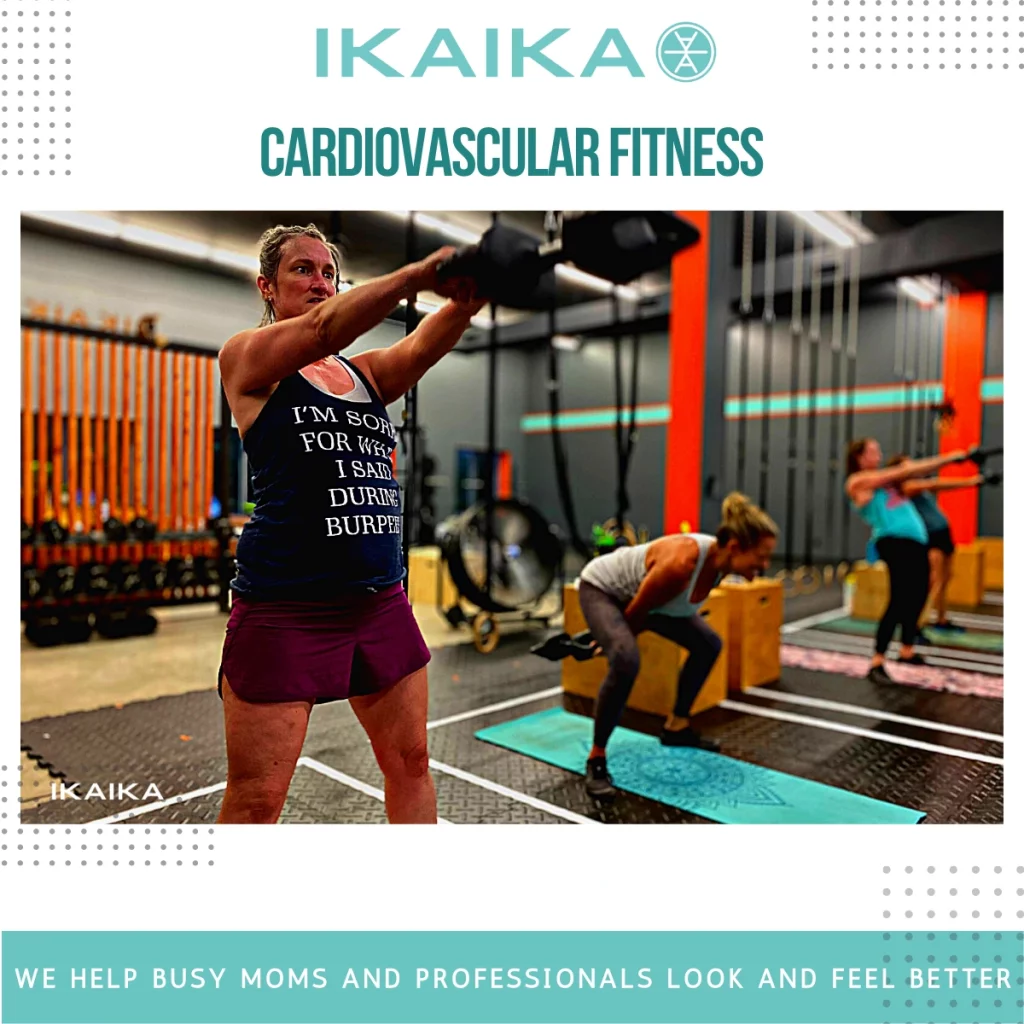
As we age, our bodies go through a lot of changes. We might not be able to do the things we could do in our 20s, and that’s ok! Our 30s are a time to focus on our fitness for health
so that we can age gracefully and enjoy a high quality of life.
Did you know that there are five components of fitness for health? These components are important for older adults because they can help increase lifespan and prevent chronic diseases. Let’s take a look at the five components of fitness and how they benefit women over 30.

Table of Contents
Flexibility is an Essential Element of Fitness for Health

Flexibility is the ability to move your joints through their full range of motion. As we age, our muscles tend to become tighter and less flexible. This can lead to joint pain, stiffness, and decreased mobility. A regular stretching routine can help improve flexibility and reduce the risk of injuries. Try adding some gentle stretching to your daily routine or taking a yoga class once a week.
The benefits of stretching regularly
Stretching regularly has countless benefits for our mind and body, yet many of us don’t make it a part of our daily routine. Fitness for health experts have long touted the benefits of stretching, both as a way to improve our physical performance and as a means of preventing injuries.
But recent research has shown that stretching can also have significant benefits for our mental health. In one study, participants who stretched for just 30 seconds reported feeling significantly more energetic and optimistic than those who didn’t stretch at all.
Furthermore, regular stretching can help to improve our sleep quality and reduce stress levels. So if you’re looking for a way to boost your energy and mood, add some stretches to your daily routine. You might be surprised at how much difference it makes.
The importance of stretching for women over 30
Fitness for health becomes increasingly important as we age. Women over the age of 30 are more likely to suffer from conditions such as osteoporosis, arthritis, and heart disease. Regular stretching can help prevent these conditions by keeping muscles and joints flexible.
It can also reduce the risk of injuries and help you to maintain your balance. In addition, stretching can improve your circulation, which is important for delivering oxygen and nutrients to your cells. And it can also help to release endorphins, which have mood-boosting properties.
So whether you’re looking to improve your fitness for health or just feel better on a day-to-day basis, regular stretching is a great way to go.
What to do if you’re struggling with flexibility
Fitness for health isn’t just about looking good. It’s about being physically and mentally healthy. And part of being physically healthy is having a good range of motion in your joints. That’s where flexibility comes in.
If you’re not very flexible, don’t worry – there are things you can do to improve. Start with some basic stretching exercises. A daily routine of stretching will help to gradually increase your flexibility.
As you become more flexible, you can start to add more challenging stretches, like yoga or Pilates. You might also want to try adding some weight-bearing exercises to your routine.
These help to strengthen the muscles around your joints, which can also improve flexibility. If you’re struggling with flexibility, don’t give up – there are plenty of things you can do to improve. With a little time and effort, you’ll be feeling better in no time.
Stretching routine for women over 30
Fitness for health is an important part of any woman’s life, but it becomes even more important as we age. Our bodies change and we become more susceptible to injuries, so it’s important to find a routine that works for us and helps us stay fit and healthy.
For women over 30, a stretching routine is a great way to stay limber and avoid injuries. We recommend doing a full-body stretch every day, focusing on the major muscle groups. Start with your legs, then move on to your arms and torso.
Hold each stretch for at least 30 seconds to give your muscles a good stretch. If you have any concerns about your fitness level or whether stretching is right for you, consult with a doctor or physical therapist.
However, for most women, adding a daily stretching routine is a simple and effective way to stay healthy and fit as they age.
Cardiovascular Fitness
Cardiovascular fitness is the ability of your heart and lungs to supply oxygen-rich blood to your muscles during sustained physical activity. Keeping your heart healthy is important for overall health and longevity. A good way to improve cardiovascular fitness is by doing interval training, which involves bursts of high-intensity activity followed by periods of rest or low-intensity activity. Interval training can be done with any type of cardio exercise, such as running, biking, or swimming.

The health benefits of cardiovascular fitness
Engaging in cardiovascular fitness is one of the best things you can do for your health. Just a few of the many benefits include reducing your risk of heart disease, stroke, and high blood pressure; improving your cholesterol levels and blood sugar control; and increasing your energy levels.
Cardio exercise also helps to keep your weight in check, strengthens your bones and muscles, and improves your mood. Regular cardiovascular exercise is as effective as antidepressants in treating depression.
So if you’re looking for a way to boost your physical and mental health, start incorporating some cardio into your routine. Your heart will thank you for it!
How much time per day you should devote to cardio workouts
Fitness for health is often misunderstood. People often think that to be healthy, they have to participate in strenuous activities for long periods. However, this could not be further from the truth.
Research has shown that moderate-intensity cardio workouts for just 30-60 minutes per day can have a significant impact on overall health. Cardio activities such as walking, jogging, and biking help to improve heart health, increase lung capacity, and boost energy levels.
Furthermore, regular cardio workouts can help to reduce stress levels, improve sleep quality, and promote weight loss. Consequently, it is important to find an activity that you enjoy and make time for at least 30-60 minutes of cardio exercise each day.
Doing so will not only improve your physical health but also your mental well-being.
The best exercises for cardiovascular fitness
Fitness for health enthusiasts are always on the lookout for new and improved ways to get their heart pumping and their blood flowing. There are a variety of exercises that can provide cardiovascular benefits, but some are more effective than others.
One of the best exercises for cardiovascular fitness is interval training. This type of exercise involves alternating between periods of high-intensity activity and periods of rest or lower-intensity activity. Interval training is an excellent way to improve heart health and stamina, and it can be adapted to any fitness level.
Another excellent option for cardiovascular fitness is aerobic exercise. This type of exercise increases heart rate and breathing, and it can be performed for long durations without interruption. Aerobic exercise is a great way to improve heart health, and it can also help to reduce stress levels.
Finally, strength training is also an effective way to improve cardiovascular fitness. Strength-training activities help to increase muscle mass, which in turn helps to improve heart function. Strength training is an ideal way to improve overall fitness levels, and it can be tailored to any individual’s needs.
All of these exercises are excellent options for improving cardiovascular fitness, but it’s important to choose the right one for you based on your fitness level and goals. By incorporating some or all of these exercises into your routine, you can enjoy all the benefits that come with improved cardiovascular fitness.
Muscular Strength
Muscular strength is the amount of force your muscles can produce in one effort. As we age, we tend to lose muscle mass due to inactivity or poor nutrition. This loss of muscle mass can lead to weakness, fragile bones, and decreased mobility.
To maintain muscle mass and strength, it’s important to do resistance training at least two times per week. Resistance training can include lifting weights, using resistance bands, or bodyweight exercises like pushups or squats.
How important is muscular strength for overall health?
Fitness for health has always been associated with good health. A strong and active body is more resistant to diseases. It is also able to heal faster from injuries. Being physically fit requires having not just endurance and flexibility, but also muscular strength.
Muscular strength is the ability of your muscles to exert force. It is important for overall fitness for health in many ways. For one, it helps to maintain proper bone density. Strong muscles also help to prevent joint pain and injuries. In addition, muscular strength is necessary for performing everyday activities such as carrying groceries or climbing stairs.
Overall, it is clear that muscular strength is vital for good health. It helps to protect our bones and joints and allows us to perform essential activities of daily living. By incorporating strength training into our fitness for health routines, we can enjoy all the benefits that a strong and healthy body has to offer.
The health benefits of maintaining muscular strength
Fitness for health is for looking good. The benefits of maintaining muscular strength are evident in many aspects of health from improved cardiovascular function to better bone density, to a lower risk of injuries.
For example, those who maintain strong muscles have an increased ability to pump blood throughout the body and therefore enjoy the better cardiovascular function. In addition, strong muscles help to support bones and protect against fractures.
Finally, strong muscles can help to prevent injuries by absorbing impact and providing support to joints. The health benefits of maintaining muscular strength are vast and varied, making it an essential component of a healthy lifestyle.
How to maintain your muscular strength as you age
As we age, it becomes increasingly important to maintain our muscular strength. Not only does this help us stay independent and mobile, but it also has a positive impact on our overall health. Here are some tips for maintaining your muscular strength as you age:
1. Make sure to include strength training in your fitness for health routine. This can be as simple as bodyweight exercises or lifting weights at the gym.
2. Focus on quality over quantity. It’s more important to do a few reps with good form than to try and lift heavier weights without proper form.
3. Warm up before your workout and cool down afterward. This will help reduce the risk of injury and help your muscles recover more quickly.
4. Listen to your body and rest when needed. Overdoing it can lead to aches, pains, and injuries, so it’s important to take things at a pace that works for you.
By following these tips, you can keep your muscles healthy and strong as you age.
What are some good exercises for improving muscular strength?
Fitness for health professionals typically recommend a mix of cardio and strength training exercises for overall fitness for health, but what if your goal is to improve muscular strength?
While many different exercises can help to build strength, some may be more effective than others. For example, compound exercises that work for multiple muscle groups at once are generally more efficient than isolation exercises that target only one muscle group.
Additionally, exercises that use free weights or body weight resistance are typically more effective than those that use machines. And finally, high-intensity interval training is more effective than traditional endurance training in building muscular strength.
So if you’re looking to improve your strength, aim to include a mix of compound, free-weight, and high-intensity exercises in your routine.
Muscular Endurance
Muscular endurance is the ability of your muscles to continue producing force without tiring, and it is an integral par or fitness for health. Like muscular strength, muscular endurance declines with age due to inactivity or poor nutrition. To maintain muscular endurance, it’s important to do exercises that challenge your muscles over some time. For example, you could try circuit training, which involves moving from one exercise to another with little rest in between. circuit training is a great way to improve muscular endurance while also getting a cardio workout!
The health benefits of endurance training
Fitness for health involves both cardiovascular endurance and muscular fitness. Cardiovascular endurance is the ability of the heart and lungs to work together to supply oxygen to the muscles for an extended period.
Muscular fitness is the ability of the muscles to work effectively to move the body and resist fatigue. A well-rounded fitness for health program should include both endurance training and strength training.
Endurance training has several health benefits, including improved cardiovascular health, increased lung capacity, and lowered blood pressure. Endurance training can also help to prevent obesity, type 2 diabetes, and some types of cancer.
In addition, endurance training can improve mental health by reducing stress, improving sleep, and increasing energy levels. For these reasons, it is important to include endurance training in a well-rounded fitness for health program.
How to increase muscular endurance
Fitness for health enthusiasts are always looking for new ways to increase their muscular endurance. Several different approaches can be taken, but some are more effective than others.
One of the most important things to remember is that muscular endurance is not the same as muscular strength. Rather, it refers to the ability of the muscles to sustain repeated contractions over an extended period. With that in mind, here are three proven methods for increasing muscular endurance:
1. High-intensity interval training: This type of training involves alternating periods of intense activity with periods of rest or recovery. For example, you might sprint for 30 seconds and then walk for 60 seconds.
This type of training is very effective at increasing muscular endurance because it forces the muscles to work harder than they would during traditional aerobic exercise.
2. Circuit training: This type of training combines resistance exercises with cardiovascular exercises. For example, you might do a set of squats followed by a set of push-ups and then a set of lunges.
This type of training is effective because it allows you to work for multiple muscle groups simultaneously and get your heart rate up at the same time.
3. Weightlifting: Unlike the other two methods, weightlifting does not necessarily involve cardiovascular exercise. However, it is still an effective way to increase muscular endurance because it forces the muscles to work hard over an extended period.
For example, you might do a set of 10 repetitions with a heavy weight and then rest for 60 seconds before doing another set.
This type of training is very effective at increasing muscular endurance because it helps to build up the mitochondria in the muscles, which are responsible for producing energy.
Body Composition
Body composition is the ratio of fat mass to lean mass (muscle, bone, water) in your body. A higher percentage of body fat is associated with increased risks for chronic diseases such as heart disease, stroke, and diabetes. To lower your body fat percentage, you need to eat a healthy diet and exercise regularly. Try adding some cardio and strength-training workouts to your weekly routine and make sure you’re eating plenty of fruits, vegetables, lean protein, and whole grains.
Body composition and health
When we think about fitness for health, we often think about our weight and how much we can bench press. However, fitness for health is so much more than that. Fitness for health is about having a body composition that allows you to live your life to the fullest and enjoy all the activities you love. Health is about having the energy and vitality to do those things.
Everyone’s ideal body composition and Fitness for health will be different based on their individual goals, but some general guidelines can help you assess whether you’re on track. A healthy body fat percentage for most people is between 20-30%.
If you’re not sure where to start, try a simple fitness for health test like the one developed by the American Council on Exercise. The test includes eight exercises that assess your muscular strength, endurance, and flexibility.
There’s no need to try to max out on any of the exercises–just do your best and see where you fall. With regular exercise and attention to your body composition, you can be on your way to a happy and healthy life.
Maintaining a healthy weight after 30
Fitness for health is not a goal that you can achieve and then forget about. It’s an ongoing journey of making healthy choices and taking care of your body. And while it may become more challenging to maintain your fitness level as you age, it’s still important to make an effort to stay at a healthy weight.
There are several things you can do to make sure you stay fit after 30. First, focus on getting regular exercise. This doesn’t mean you have to join a gym or start working out every day. But you should make an effort to get 30 minutes of moderate exercise most days of the week. This could include walking, biking, swimming, or even just taking the stairs instead of the elevator.
Another important part of maintaining a healthy weight after 30 is watching what you eat. Just like your exercise routine, your diet should be one that you can maintain for the long term. That means eating mostly whole foods – plenty of fruits, vegetables, and whole grains – and avoiding processed foods as much as possible.
It also means paying attention to portion sizes and not overeating. And finally, don’t forget to make time for meal planning and prep so you always have healthy food options available.
Making healthy choices now will help you stay fit and prevent weight gain later in life. And while it may take some extra effort, it’s worth it for your long-term health and well-being.
Final Thoughts from IKAIKA
The five health-related components of fitness for health are important for women over 30 because they can help improve their lifespan and prevent chronic diseases.
To improve these components of fitness for health, try adding some cardio exercises like interval training or swimming to your weekly routine along with some strength-training exercises like lifting weights or doing bodyweight exercises such as pushups or squats.
Eating a healthy diet rich in fruits, vegetables, lean protein, and whole grains will also help improve body composition. Taking care of your health now will pay off in the long run! Thanks for reading!
IKAIKA Fitness strives in providing personalized programs that are safe, fast-paced, and efficient so busy moms and professionals can get back on track with their life goals – whether it’s exploring new places or just taking care of themselves mentally by seeking adventure through the activity!
We provide a safe, flexible and effective way to help you reach your fitness for health goals.
Read what our members are saying about us, and how satisfied they are with the results through our Google Reviews.
We use functional movements along with customized nutrition plans so that we can get the most out of each workout for optimal results – it’s all about having fun while achieving success!
Schedule your FREE No-Sweat Intro so that we can learn about your goals, and help you reach them.
References
- What Are the 5 Health-Related Components of Physical Fitness?
- What is Fitness?
- World Class Fitness in 100 Words
- Benefits of Physical Activity
- Why is physical activity so important for health and well-being?
- Real-Life Benefits of Exercise and Physical Activity
- Physical activity
- 5 Health-Related Components of Fitness
- Nutrition and Fitness: Mental Health
- Impact of high-intensity interval training on cardiorespiratory fitness, body composition, physical fitness, and metabolic parameters in older adults: A meta-analysis of randomized controlled trials
- Novel all-extremity high-intensity interval training improves aerobic fitness, cardiac function and insulin resistance in healthy older adults
- All-Extremity Exercise Training Improves Arterial Stiffness in Older Adults
- Twelve weeks of low volume sprint interval training improves cardio-metabolic health outcomes in overweight females
- Physiological Responses to Low-Volume Interval Training in Women
- MacInnis MJ, Gibala MJ. Physiological adaptations to interval training and the role of exercise intensity. J Physiol. 2017;595(9):2915–2930. doi: 10.1113/JP273196